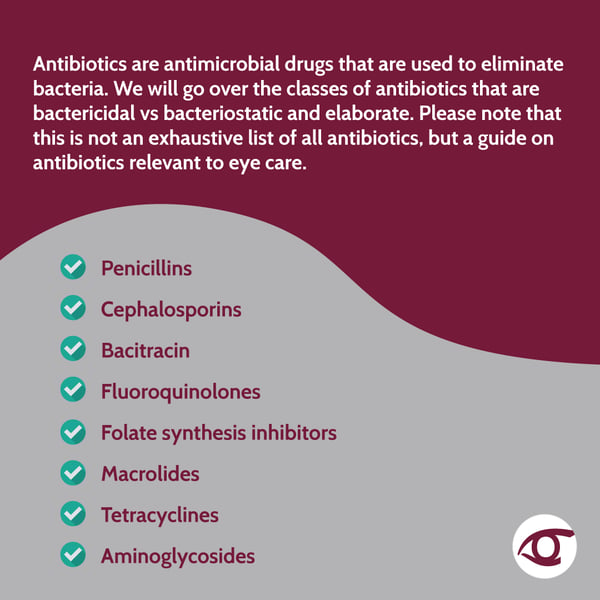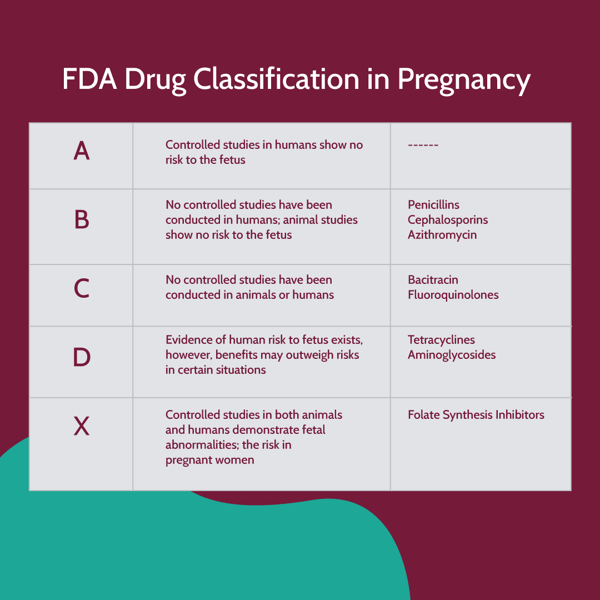
Antibiotics are one of the most common types of pharmaceuticals prescribed by physicians. There are many different classes of antibiotics, each useful for a different subset of conditions.
Antibiotics are mainly used for, but not limited to, conditions related to the front surface of the eye. Many practitioners pick their antibiotic of choice and prescribe, overlooking the general health and allergic history of the patient.
Today, we will review the many different antibiotics relevant to eye care and available to ODs, their indications, and most importantly, when to use caution!
First, let’s review! Antibiotics are antimicrobial drugs that are used to eliminate bacteria. They can do this in one of two ways. An antibiotic can block the synthesis of the bacterial cell wall, thus killing the bacteria. This type of antibiotic is called bactericidal.
On the other hand, an antibiotic can also slow down the replication of the bacteria, thus lowering its ability to spread. This type of antibiotic is called bacteriostatic. We will go over the classes of antibiotics that are bactericidal vs bacteriostatic and elaborate. Please note that this is not an exhaustive list of all antibiotics, but a guide on antibiotics relevant to eye care.

Penicillins
Penicillins are composed of a thiazolidine ring and a Beta-lactam ring. They inhibit the enzyme transpeptidase, which is responsible for cross-linking and building the cell wall of the bacteria, resulting in a disorganized and disturbed structure. Penicillins are therefore classified as bactericidal. Note that some infections involving the eye, specifically infections due to Staphylococcus aureus and Staphylococcus epidermidis, need antibiotics that are resistant to penicillinase.
Indications:
- Eyelid Infections (i.e. dacryocystitis, orbital cellulitis, hordeola)
- Amoxicillin: not resistant to penicillinase
- Dicloxacillin: resistant to penicillinase
- Augmentin (Amoxicillin/clavulanic acid): resistant to penicillinase
Caution: Adverse reactions in penicillins are linked to hypersensitivity. Oral penicillins may cause vomiting and diarrhea. Amoxicillin can cause Stevens-Johnson syndrome.
Cephalosporins
Cephalosporins are composed of a dihydrothiazine ring and a Beta-lactam ring. Cephalosporins also block cell wall synthesis by inhibiting the enzyme transpeptidase. First generation cephalosporins have good gram positive coverage, and gram negative coverage increases in 3rd and 4th generations.
Indications:
- Eyelid infections (i.e. hordeola)
- Cephalexin (Keflex®): 1st generation
- Severe orbital infections (i.e. orbital cellulitis, Pseudomonas)
- Ceftriaxone (Rocephin®): 3rd generation: IV and IM only
Caution: Use caution in patients with penicillin allergy since cross-sensitivity exists. Hypersensitivity reactions are common. Cephalosporins should be avoided in patients with hemophilia. About 10% of patients who are allergic to penicillins will have sensitivity with cephalosporins.
Bacitracin
Bacitracin also prevents formation of the cell wall and is bactericidal. It is used topically in combination with other antimicrobials for maximum effects.
Indications:
- Mild eyelid/skin conditions (i.e. blepharitis)
- Bacitracin/polymyxin B (Polysporin®)
- Polysporin® /neomycin (Neosporin®)
Caution: Though rare, hypersensitivity reactions have been reported in the form of contact dermatitis.
Fluoroquinolones
Fluoroquinolones inhibit bacterial DNA synthesis leading to cell death. Fluoroquinolones attack DNA gyrase and topoisomerase IV, which are not found in human cells.
Indications:
- Contact lens related infections/ulcers, severe ocular surface conditions
- Ciprofloxacin
- Ofloxacin (Ocuflox®)
Caution: Oral fluoroquinolones should be used with caution since they can cause tendinitis.
Folate synthesis inhibitors
Folate synthesis inhibitors are a class of antimicrobials that impact the folic acid metabolism of bacteria. These drugs include sulfonamides, pyrimethamine and trimethoprim. Sulfonamides inhibit the synthesis of folic acid by attacking the first step in its synthesis. Pyrimethamine and trimethoprim attack the second step by inhibiting the reduction of dihydrofolic acid to tetrahydrofolic acid.
Indications:
- Eyelid/eye surface conditions (i.e. hordeola, conjunctivitis, etc.)
- Trimethoprim/Polymyxin B (Polytrim®)
- Trimethoprim/sulfamethoxazole (Bactrim®)
Caution: Patients can experience myopic shift secondary to sulfonamides. Both oral and topical sulfonamides can cause Stevens-Johnson syndrome.
Macrolides
Macrolides bind to the 50S ribosomal subunit of bacteria, inhibiting growth. Macrolides have low toxicity levels because they are selective towards bacterial ribosomes only.
Indications:
- Lid and lid margin disease (i.e. blepharitis)
- Erythromycin (topical)
- Azithromycin (oral and topical)
Caution: Hypersensitivity reactions are common.
Tetracyclines
Tetracyclines bind to the 30S ribosomal subunit of the bacteria. Note that since tetracyclines have been widely used, they have increased bacterial resistance.
Indications:
- External eye conditions (i.e. inclusion conjunctivitis, trachoma, etc.)
- Doxycycline
- Tetracycline
- Non-infectious eye conditions (i.e. rosacea, meibomian gland dysfunction)
- Doxycycline (low dose)
Caution: Photosensitivity reactions are common with tetracyclines. Caution in patients with renal disease, except with doxycycline. Children under age 8, pregnant women, and nursing mothers should avoid tetracyclines due to suppression of embryonic growth and permanent tooth discoloration during development. Pseudotumor cerebri can also be caused by the use of oral tetracyclines in children and adults. Discontinue immediately if suspected.
Aminoglycosides
By binding to the 30S ribosomal subunit of the bacteria, aminoglycosides prevent bacterial protein synthesis. Aminoglycosides are considered to be bactericidal against bacteria that are known to attack the eye and eyelid. Aminoglycosides have more gram negative than gram positive coverage.
Indications:
- External eye conditions (i.e. conjunctivitis, blepharitis, etc.)
- Gentamicin
- Tobramycin
Caution: High concentrations of aminoglycosides can accumulate in the kidney. However, side effects are uncommon with topical use of gentamicin and tobramycin.

Now that we have analyzed the different types of antibiotics related to eye care, you will be able to identify the class that would be most beneficial to your specific patient. Remember to ask about any and all medication allergies, medical conditions and most importantly pregnancies in your female patients!
- Dr. Amadian
